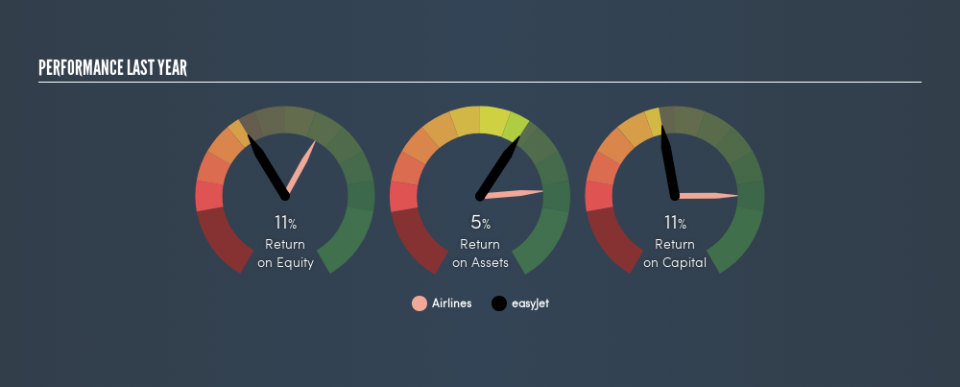Should You Worry About easyJet plc’s (LON:EZJ) ROCE?

Want to participate in a short research study? Help shape the future of investing tools and you could win a $250 gift card!
Today we'll evaluate easyJet plc (LON:EZJ) to determine whether it could have potential as an investment idea. Specifically, we're going to calculate its Return On Capital Employed (ROCE), in the hopes of getting some insight into the business.
First, we'll go over how we calculate ROCE. Second, we'll look at its ROCE compared to similar companies. Then we'll determine how its current liabilities are affecting its ROCE.
Return On Capital Employed (ROCE): What is it?
ROCE measures the 'return' (pre-tax profit) a company generates from capital employed in its business. Generally speaking a higher ROCE is better. Overall, it is a valuable metric that has its flaws. Renowned investment researcher Michael Mauboussin has suggested that a high ROCE can indicate that 'one dollar invested in the company generates value of more than one dollar'.
How Do You Calculate Return On Capital Employed?
Analysts use this formula to calculate return on capital employed:
Return on Capital Employed = Earnings Before Interest and Tax (EBIT) ÷ (Total Assets - Current Liabilities)
Or for easyJet:
0.11 = UK£531m ÷ (UK£7.0b - UK£2.1b) (Based on the trailing twelve months to September 2018.)
So, easyJet has an ROCE of 11%.
Check out our latest analysis for easyJet
Is easyJet's ROCE Good?
ROCE can be useful when making comparisons, such as between similar companies. We can see easyJet's ROCE is meaningfully below the Airlines industry average of 15%. This performance is not ideal, as it suggests the company may not be deploying its capital as effectively as some competitors. Regardless of where easyJet sits next to its industry, its ROCE in absolute terms appears satisfactory, and this company could be worth a closer look.
As we can see, easyJet currently has an ROCE of 11%, less than the 23% it reported 3 years ago. This makes us wonder if the business is facing new challenges.
Remember that this metric is backwards looking - it shows what has happened in the past, and does not accurately predict the future. ROCE can be deceptive for cyclical businesses, as returns can look incredible in boom times, and terribly low in downturns. ROCE is, after all, simply a snap shot of a single year. What happens in the future is pretty important for investors, so we have prepared a free report on analyst forecasts for easyJet.
What Are Current Liabilities, And How Do They Affect easyJet's ROCE?
Short term (or current) liabilities, are things like supplier invoices, overdrafts, or tax bills that need to be paid within 12 months. Due to the way the ROCE equation works, having large bills due in the near term can make it look as though a company has less capital employed, and thus a higher ROCE than usual. To counter this, investors can check if a company has high current liabilities relative to total assets.
easyJet has total liabilities of UK£2.1b and total assets of UK£7.0b. Therefore its current liabilities are equivalent to approximately 29% of its total assets. A fairly low level of current liabilities is not influencing the ROCE too much.
Our Take On easyJet's ROCE
With that in mind, easyJet's ROCE appears pretty good. easyJet looks strong on this analysis, but there are plenty of other companies that could be a good opportunity . Here is a free list of companies growing earnings rapidly.
For those who like to find winning investments this free list of growing companies with recent insider purchasing, could be just the ticket.
We aim to bring you long-term focused research analysis driven by fundamental data. Note that our analysis may not factor in the latest price-sensitive company announcements or qualitative material.
If you spot an error that warrants correction, please contact the editor at editorial-team@simplywallst.com. This article by Simply Wall St is general in nature. It does not constitute a recommendation to buy or sell any stock, and does not take account of your objectives, or your financial situation. Simply Wall St has no position in the stocks mentioned. Thank you for reading.

 Yahoo Finance
Yahoo Finance 
